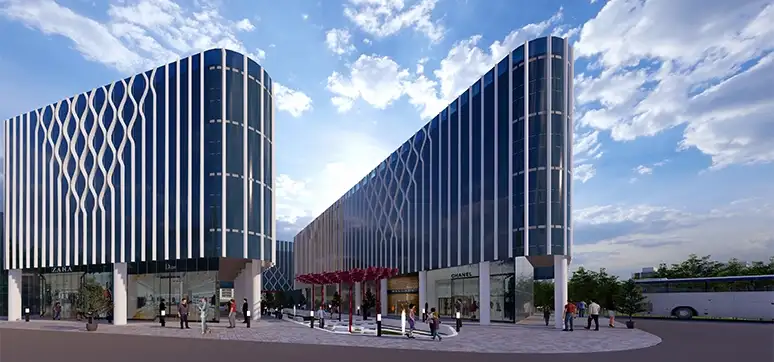Cladding acts like the skin of the built form and is an integral part of the building. Innovative cladding designs can add more aesthetics to the building and can add more value to the character of the building. Most of us see cladding systems as a means to provide an architectural expression with a high-impact aesthetic layer to the building. We often delve with parametric techniques to design the geometric system for cladding followed by play of materials and colours, says Ar. Sushant Verma, Founder, rat[LAB] Studio.
Exterior wall cladding serves several important purposes in the construction & design of buildings. Cladding enhances the visual appearance of a building and contributes to its overall design and architectural style. It provides a protective barrier against the elements, such as rain, wind, snow, and sunlight. Cladding protects the underlying structure from wear and tear, increasing the building’s lifespan and reducing maintenance requirements. Some cladding materials offer improved fire resistance, which can enhance the overall safety of the building and its occupants, points out Sumit Sahay, General Manager, VM Zinc.
![AR. SUSHANT VERMA Founder, rat[LAB] Studio](https://wfmmedia.com/wp-content/uploads/2023/10/Ar.-Sushant-Verma-150x150.jpg)

Verma agrees that the purpose of exterior wall cladding is to protect the building against weather elements. It also serves as an insulating layer, improving energy efficiency and thermal comfort. Cladding enhances the building’s aesthetics, acting as the outer skin and contributing to its architectural expression. Additionally, cladding can offer sound insulation, fire resistance, and durability, ensuring the longevity of the structure, adds Verma.
Cladding is when materials are applied on top of others, in layers, on the exterior of a building and it is designed to improve thermal insulation, weather resistance, and appearance, amongst many other benefits. Cladding is often assembled in panels. These component panels are attached to the structural frame of your main building and can be developed bespoke or installed ‘off the shelf’ to fit, says

Ar. Niket Sunil Upase, Founder Architect, Ahamasmi Architect Some cladding systems include panels and fastenings, while others feature windows, doors, gutters, roof lights and vents. It improves the interior environment quality of the space and acts to control the heat coefficient ratio and thermal mass. With the right cladding, we can improve the building depreciation due to UV rays, climatic moisture, and other climatological factors, adds Upase.

According toAr. P S Vigneswar, Principal Architect, Architecture + Value, cladding is an adaptable and affordable answer for aesthetics that also works as an exterior skin to resist external agents, thus increasing the all-inclusive durability of the building. Utilising appropriate cladding material wherever it is needed is a crucial point that should not be overlooked. In the building industry cladding is a boon to many who invent, create and experiment with designs. For designers, it can be an identity of their creations.

Ar. Priyanka Arjun, Head Architect, Priyanka Arjun and Associates lists the key benefits of cladding:
- Insulation: Enhances thermal performance by adding an extra insulation layer.
- Beautification: Offers varied designs, textures, and colours for improved aesthetics.
- Faster renovation process: Enables swift installation compared to other methods.
- Durability and longevity: Increases building lifespan by safeguarding against wear and tear, reducing maintenance costs.
- Ease of maintenance: Reduces environmental exposure, leading to fewer repairs and lower maintenance expenses.
What are the Best Building Cladding Systems?
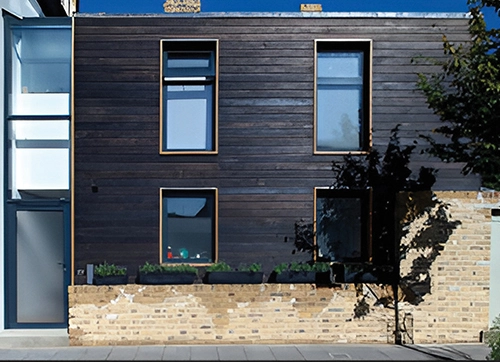
Timber cladding
Timber is still one of the most aesthetically attractive cladding materials, says Upase. Timber cladding is often put in long, narrow boards laid horizontally, vertically, or diagonally. The finished product can be completely customized to create the aesthetic look you like. Bringing natural beauty, warmth, and sustainability, wood cladding enhances a building’s appeal while delivering functional advantages for both exteriors and interiors.

Metal cladding is a method of protecting one metal (or composite) by forming a layer of a second metal on its surface by using techniques such as diffusion, deformation and lasers. Metal cladding is also used on the outer surfaces of structures as well as buildings for corrosion and abrasion protection.
Fibre cement cladding: Fibre cement is made from sand, cement and cellulose fibres. Fibre cement cladding is a popular choice for builders because it is simple to install, weatherproof, and resistant to water.

Natural stone provides buildings with a luxurious and timeless aesthetic, offering various stone types for diverse aesthetic choices. Stone cladding is more often found in residential homes than in commercial ones. Stone is ideal for giving homes an attractive, opulent appearance while maintaining a classic “country home” atmosphere.
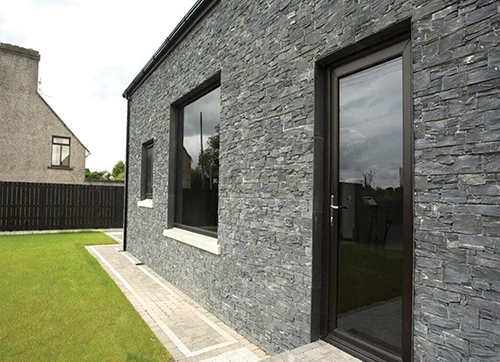
Vinyl cladding is perfect for people seeking a contemporary, modern material that comes in various colours. Because vinyl is still one of the least expensive cladding materials and has demonstrated energy efficiency. It is cost-effective during the installation process and in the future. Panels can even be installed with an extra layer of insulation, forming a temperature-controlling blanket over your property, keeping it warm in the winter and cool in the summer.
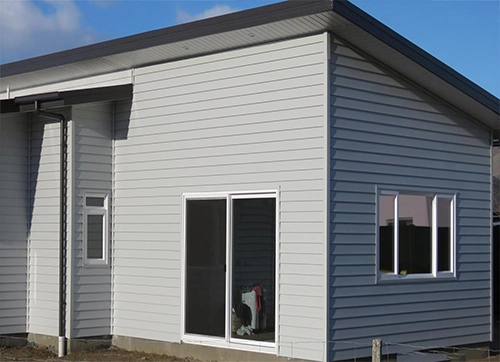
Zinc cladding is a type of metal cladding. It comes in many different forms and sheets can be formed into shingles, cassette panels and flat-lock panels to suit any type of building. Zinc is sometimes chemically treated to slightly alter its naturally shiny finish. These treatments are usually designed to weather it quickly, giving it a patina that would take between three and 10 years to develop naturally. Zinc is also sometimes combined with small amounts of other alloys, such as titanium and copper, to increase its malleability, durability, and corrosion resistance Featuring a natural patina that evolves, zinc offers an appealing, distinctive building appearance. Its durability, corrosion resistance, and extended lifespan make it an excellent choice.
Copper cladding involves covering with copper sheets or panels, offering a striking appearance that evolves. Copper has been a favoured cladding material for centuries due to its unique characteristics.
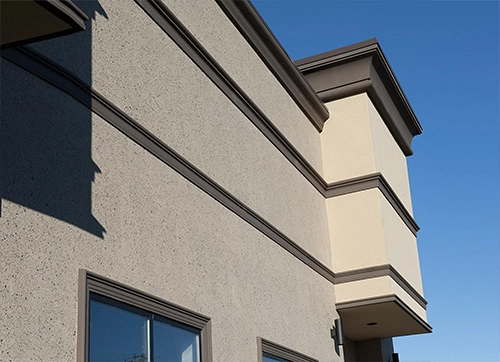
Stucco wall – Stucco is a cement-type mixture made of Portland cement, lime, sand and water. It is a thin finish coat that goes on the outermost layer of residential and commercial constructions. Modern stucco has polymers and other agents for increased flexibility that improves its resilience. Stucco is very durable.
Bricks cladding, also called “Face Bricks”, can be specified in a large number of colours and textures, and their summation and variation –thanks to their different shapes and sizes – they can create façades of great complexity and beauty. A perennial favorite, traditional brick cladding boasts classic looks and enduring strength, often applied as a veneer over other materials.
(Ar. Niket Sunil Upase, Founder Architect, Ahamasmi Architect & Priyanka Arjun, Head Architect, Priyanka Arjun and Associates)
Cladding Materials and Systems in Vogue
![Interesting façades – designed by rat[LAB] Studio](https://wfmmedia.com/wp-content/uploads/2023/10/Interesting-facades-–-designed-by-ratLAB-Studio.webp)
The “best” building cladding system depends on various factors, including the specific project requirements, budget, design considerations, local climate, and building regulations, says Sahay. Different cladding systems offer unique advantages and disadvantages.
In today’s modern and parametric architecture, metal cladding has an edge over other cladding materials for the following reasons:
- Contemporary aesthetics
- Design flexibility
- Sustainability and recyclability
- Durability and low maintenance
- Versatility with other materials
- Lightweight construction
- Fire resistance and safety
- Ease of installation
The best building cladding systems depend on the project’s specific requirements and design intent. Popular options include aluminium composite panels for their lightweight and versatility, fiber cement for their durability, wood siding for a natural look, and stone siding for a timeless and robust appearance. Zinc and copper offer unique patina effects, while brick provides a classic & enduring façade. Each cladding system has its merits in terms of aesthetics, performance, and maintenance, making careful selection crucial for successful outcomes. “With the current set of projects, we work a lot with mild steel sections (for curvilinear profiles & lower costs) as well as aluminium profiles and ACP as it can be CNC routed to create different shapes and sizes, adds Verma.
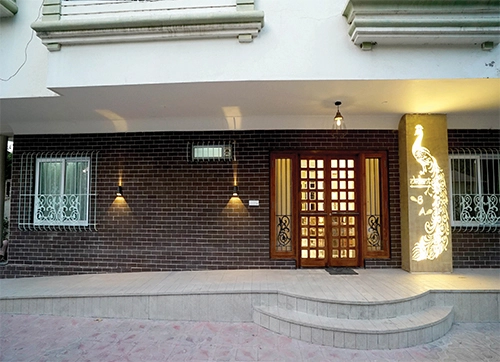
For more than a decade, glass, stone, wood, and metal/ACP have always been the traditional choice of material for exterior cladding. Nowadays, new and innovative materials such as exterior grade laminates (as per EN438-6), glass fibre reinforced concrete, and metal cladding (zinc, copper, and steel) are creating a healthy disruption in the market. The differentiating advantages of exterior grade laminates are their Eco-friendliness, thermal efficiency, energy renewability and sustainability, points out Upase.
The use of various materials other than traditional materials use as steel or even tensile fabrics has also ventured into the market, notes Vigneswar. The commercial and hospitality genre has shown the trend of the ever-changing skin of the building. He too is in favour of materials such as tensile fabric, and CNC-cut ACP screen walls as exterior wall skin to create dynamic shadow and light effects that act as a curtain from external elements.
Ar. Priyanka Arjun adds Corten Steel Cladding as one of the favourites since this weathering steel develops a distinctive rust-like patina over time, enhancing its allure in contemporary designs. Its durability, weather resistance, and low maintenance make it ideal for various climates, ensuring long-lasting structural integrity. She adds that Zinc, as an excellent material, offers exceptional durability, resistance to corrosion and weathering, and UV radiation. Its lightweight nature facilitates cost-effective transportation and installation, while its malleability allows for intricate and creative designs.
A trending approach in parametric designs, brick cladding enables diverse forms and patterns, adding a rustic and homely character to the space. These cladding options not only enhance a property’s visual appeal but also exemplify sustainable and contemporary design principles. Engineered wood laminates provide a sustainable and visually appealing option. High-tech materials like translucent polycarbonate panels and 3D printed cladding are gaining popularity for their innovative designs, adds Verma. Ventilated façades using terracotta or ceramic tiles present a stylish choice. The market offers a broad spectrum of cladding materials catering to diverse architectural styles and preferences.
Several trendy exterior cladding materials were gaining popularity in the market, each offering unique aesthetics and features.
Here are some cladding materials that are trending:
- Single skin metal cladding: Various metal cladding like copper, zinc, titanium, corten steel, solid aluminium, PVD, and stainless steel metal claddings are being used in India
- Metal perforated screens/mesh panels: customised perforated screens/ metal mesh screens or panels, made from materials like zinc, aluminium, or stainless steel
- Terracotta cladding
- Glass-reinforced concrete (GRC)
- Glass fibre reinforced concrete
- Ceramic cladding
- Polytetrafluoroethylene (PTFE) coated fiberglass non-ventilated fabric Remember that trendy materials may suit some projects and architectural styles better than others. When choosing an exterior cladding material, it’s essential to consider factors such as design intent, climate, maintenance requirements and the expected life of the building.
(Sumit Sahay, Designation – General Manager , VM Zinc)
Selection of Cladding Materials
The selection of materials after understanding the material and how it will be affected if used at a specified site should be the main factor. The material’s contradictory disposition can sometimes be a highlighting feature if used correctly. When recommending exterior wall cladding materials for a specific project, several key factors should be taken into consideration to ensure the best fit for the building’s requirements and the client’s preferences.
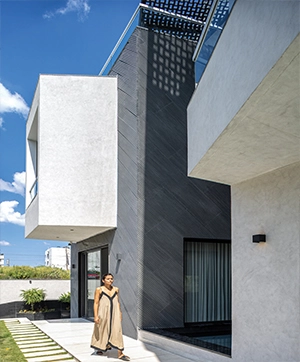
beautiful residence designed by Priyanka
Arjun and Associates
Here are the key factors to consider:
- Aesthetics, architectural style and design intent
- Durability and maintenance
- Climate, weather conditions and exposure
- Cost and budget
- Buildability, Shape and Size
- Compatibility with the building’s structural system
- Environmental impact
- Sustainability
- Energy efficiency
- Insulation and acoustics
- Fire resistance and safety
By carefully considering these factors and conducting a thorough analysis of the project’s needs, one can recommend exterior wall cladding materials that not only enhance the building’s appearance but also provide long-lasting performance and value.
CLADDING MATERIALS FOR HIGH-RISES AND LOW-RISES
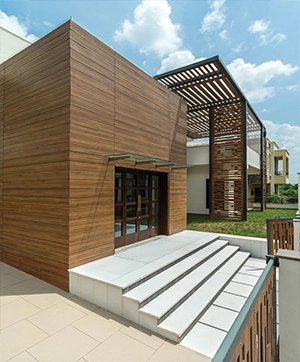
grand residential project by Priyanka Arjun and Associates
Material specifications like weight, durability, porosity and other factors are major factors along with the fixing of the materials. Unlike low-rise buildings, the high-rise has certain hurdles when it comes to fixing materials and the load of material has to be calculated to withstand the other influences, points out Vigneswar. The use of metals, glass and concrete are the practical alternatives for high-rise but other materials used in appropriate proportions can also be a design solution.
Cladding Material Choices For High-Rise Buildings:
1. Glass: Modern and transparent, allowing ample natural light. Often combined with other materials for a sleek look.
2. Metal Panels: Lightweight and versatile, available in various shapes and finishes, offering a modern and industrial appearance.
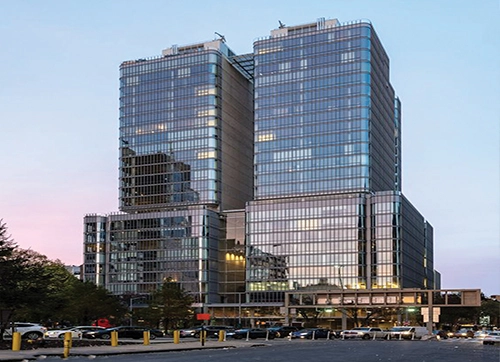
It’s crucial to consider local building regulations and codes, as some cladding materials may have specific fire safety requirements. Consultation with professionals in architecture, engineering, and construction is essential.
For Low-Rise Buildings:
- Wood Cladding: Provides a natural and traditional look, available in various wood species. Regular maintenance is required for weathering and pest protection.
- Brick: One of the oldest and most durable materials, offering a classic and timeless appearance with a range of sizes, colours and textures.
- Stone: Granite, limestone, and slate present a luxurious and elegant exterior, lending buildings a sturdy and enduring impression.
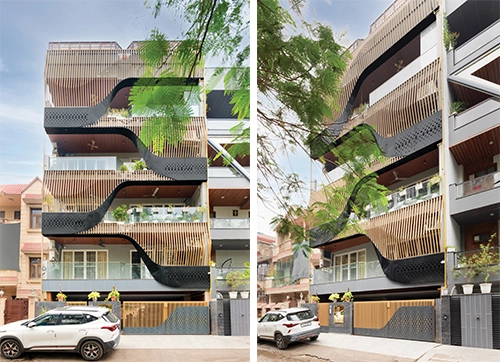
For high-rises, lightweight and efficient cladding systems are preferred to reduce the building’s overall load and ensure structural stability. Modern trends emphasise sleek designs, using materials like glass, aluminium, and composite panels to create a contemporary and dynamic appearance. In contrast, low-rises often incorporate natural materials like wood or stone to harmonize with the surroundings and offer a more grounded and inviting aesthetic. Both high-rises and low-rises prioritize sustainability, employing green technologies and responsive facades to enhance energy performance, concludes Verma.
The following are some of the latest trends in designing exterior cladding for high-rise and low-rise buildings.
High-Rise Buildings:
- Glass and Steel Combinations: High-rise buildings often feature a sleek and modern aesthetic, with extensive use of glass and steel. Large curtain walls made of glass provide transparency, natural light, and panoramic views while steel elements offer structural support and add a touch of sophistication.:
- Dynamic Façades: Architects are increasingly experimenting with dynamic Façades that can change shape or appearance. This can be achieved through movable panels, kinetic elements, or digitally controlled shading devices. These Façades create an ever-changing look for the building and respond to environmental conditions.
- Green Façades: Sustainable design is gaining prominence, and green facades featuring climbing plants or vertical gardens are becoming more popular. These living Façades not only add visual appeal but also provide insulation, improve air quality, and contribute to the building’s environmental performance.
- Mix of Materials: High-rises often incorporate a mix of cladding materials to add visual interest and texture. Combining materials like glass, metal, stone, and concrete can create a harmonious yet captivating Façades.
- Parametric Design: Parametric design uses algorithms to generate complex and innovative geometries. This approach allows for intricate and unique cladding patterns that cater to the specific needs of the building and its surroundings.
Low-Rise Buildings
![Glass façade curtain walls – a design by Rat [LAB] Studio](https://wfmmedia.com/wp-content/uploads/2023/10/Glass-facade-curtain-walls-–-a-design-by-Rat-LAB-Studio.webp)
- Artisanal Cladding: There is a growing interest in artisanal and handcrafted cladding materials that add a sense of uniqueness and craftsmanship to low-rise buildings. This includes materials like handmade tiles, textured clay panels, and bespoke stonework. Brickwork Innovations: Traditional brick cladding is being reimagined with innovative patterns, colors, and textures. Feature walls or playful arrangements of bricks are used to create focal points on the façade.
- Sculptural Facades: Some low-rise buildings feature sculptural elements as part of their cladding design. These artistic features add character and make the building stand out in its context.
(Sumit Sahay, Designation – General Manager , VM Zinc)
FIRE-SAFE CLADDING
All cladding materials have different compositions which can affect the heat conducting properties, that will directly affect the immediate structure. For example, though aluminium composite material is lightweight, durable and easy to install, it’s the least safe when it comes to fire, states Vigneswar. Ar. Priyanka adds that fire seals are vital elements in cladding systems, placed around openings like windows and doors. Made from fire-resistant materials like fire-rated silicone, intumescent strips, or fire-resistant mineral wool, they seal off gaps and joints during fires.
To ensure proper fire safety, adherence to local building codes and consulting fire safety professionals are essential. Fire-resistant cladding materials and well-designed fire seals protect lives and property during fire incidents, notes Ar. Priyanka.
Fire safety assurance for cladding systems involves:
Materials undergo rigorous tests to assess their behavior in fire conditions, including reaction, smoke production, heat release rate, and flame spread.
- Fire Resistance Rating
Some jurisdictions require specific fire resistance ratings, indicating the cladding system’s ability to withstand fire for a defined period.
- Compliance with Building Codes and Standards
Cladding systems must adhere to local regulations, with specific requirements based on building height, occupancy, and location.
Ensuring that cladding materials and installation methods are fire-safe is of paramount importance in building design and construction. Sahay lists the steps that can be taken to achieve fire safety in cladding:
-
Fire Testing and Certification
Cladding materials can undergo fire testing to assess their fire-resistant properties. There are various fire test standards depending on the country and region, such as ASTM E84, BS 476, EN 13501, and NFPA 285. These tests evaluate factors like flame spread, heat release rate, smoke production, and combustibility.
-
Third-Party Certification
Look for cladding materials that have been independently tested and certified by reputable third-party organizations.
-
Fire-Resistant Cladding Materials
Choose cladding materials that are inherently fire-resistant. Materials like metal Zinc, copper, fiber cement, and certain types of stone have good fire-resistant properties.
Verma advises to choose fire-resistant materials like non-combustible metal panels or fibre cement, to minimise the risk of fire spread. Verify that the cladding meets relevant building codes and standards for fire resistance. Additionally, use fire-resistant insulation materials and incorporate fire-stopping measures at joints and penetrations. Look for third party certifications, such as ASTM E84 or EN 13501, which indicate the material’s fire performance. Engage experienced installers who follow proper fire-safe installation practices to maintain the façade’s integrity.
CONCLUSION
Exterior wall cladding is an essential component in the construction of modern buildings and structures. It enhances the building’s aesthetic look and increases the durability of its exterior. External wall cladding provides long-term protection for your building against all environmental factors and pollutants, without compromising on the beauty & designs. It also improves the property’s structural strength and resilience to abrasion, fractures, and scratches.
The cladding is put in place using techniques that create a barrier between the exterior walls and the environment. This includes installing an air gap between the cladding and the walls to allow for proper ventilation that maintains a favorable temperature inside while also preventing moisture build-up. The cladding material selection among different options is a crucial issue affected by quality and cost. The implementation of the value engineering (VE) process is challenging. This edition’s cover story proposes a framework for the selection of efficient cladding materials and integrating them with the design of the façade.
